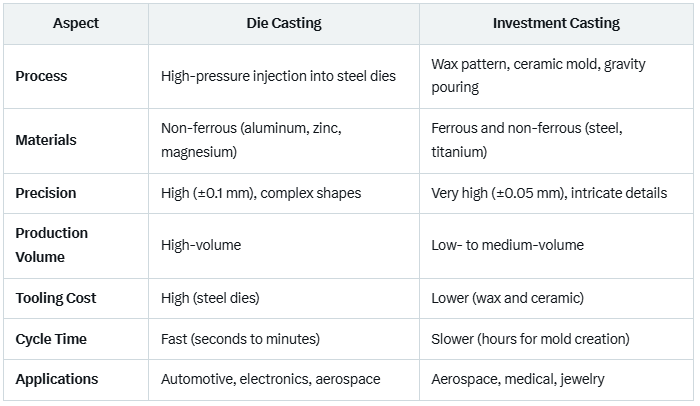Shenzhen Alu Rapid Prototype Precision Co., Ltd.
Industry News
- Home
- News
- What is the difference between die casting and investment casting
Die casting and investment casting are both metal casting processes used to create precise metal parts, but they differ significantly in their methods, materials, applications, and outcomes. Below is a concise comparison:
1. Process
Die Casting:
Molten metal is injected under high pressure (1,000–30,000 psi) into a reusable steel mold (die).
The metal solidifies quickly, and the part is ejected.
Two types: hot chamber (for low-melting-point metals like zinc) and cold chamber (for higher-melting-point metals like aluminum).
Fast cycle times (seconds to minutes).
Investment Casting:
A wax pattern is created, coated with a ceramic shell, and then melted out, leaving a mold cavity.
Molten metal is poured into the ceramic mold, typically by gravity, and solidifies.
The ceramic shell is broken away to retrieve the part.
Slower process with longer cycle times due to mold creation and drying.
2. Materials
Die Casting: Primarily uses non-ferrous metals with lower melting points, such as aluminum, zinc, magnesium, and copper alloys.
Investment Casting: Suitable for a wider range of metals, including ferrous (e.g., stainless steel, carbon steel) and non-ferrous alloys (e.g., aluminum, brass, titanium).
3. Precision and Complexity
Die Casting:
High precision with tight tolerances (±0.1 mm).
Excellent for complex shapes with thin walls (as thin as 1–2 mm).
Smooth surface finish, often requiring minimal post-processing.
Investment Casting:
Exceptional precision, capable of intricate details and fine tolerances (±0.05 mm).
Ideal for highly complex geometries, including undercuts and internal features.
Superior surface finish, often smoother than die casting.
4. Production Volume
Die Casting: Best suited for high-volume production due to high initial tooling costs (steel dies are expensive) and fast cycle times.
Investment Casting: More cost-effective for low- to medium-volume production, as wax patterns and ceramic molds are less expensive but time-consuming to produce.
5. Tooling and Costs
Die Casting:
High initial tooling costs due to durable steel dies.
Lower per-part cost in high-volume runs due to rapid production.
Investment Casting:
Lower initial tooling costs (wax patterns and ceramic molds are cheaper).
Higher per-part cost due to labor-intensive mold creation and longer process times.
6. Applications
Die Casting: Common in automotive (engine blocks, transmission housings), aerospace (structural components), electronics (enclosures), and consumer goods (e.g., power tool housings).
Investment Casting: Used in aerospace (turbine blades), medical (implants, surgical tools), jewelry, and industries requiring high-precision, intricate parts (e.g., pump impellers).
7. Advantages
Die Casting:
High production speed and efficiency.
Cost-effective for large-scale manufacturing.
Consistent quality for high volumes.
Investment Casting:
Greater material versatility (ferrous and non-ferrous).
Superior for small, intricate parts or low-volume runs.
Minimal material waste due to precise mold design.
8. Limitations
Die Casting:
Limited to non-ferrous metals.
High tooling costs make it less viable for small batches.
Less suitable for very intricate internal features.
Investment Casting:
Slower and more labor-intensive.
Higher per-part cost for large volumes.
Ceramic molds are single-use, increasing material costs.
Relevance to Shenzhen Alu Rapid Prototype Precision Co., Ltd.
Shenzhen Alu Rapid Prototype Precision Co., Ltd. likely uses die casting for high-volume, precision aluminum parts (e.g., for automotive or aerospace), given their focus on CNC machining, injection molding, and rapid prototyping. We may also offer investment casting for smaller runs or more intricate components, especially for clients requiring diverse materials or complex geometries.

Both processes excel in precision manufacturing, but die casting is optimized for speed and volume, while investment casting offers flexibility for intricate, low-volume parts.
